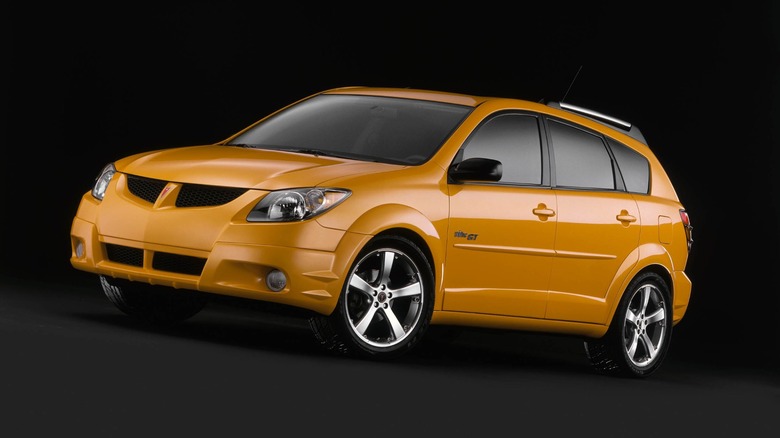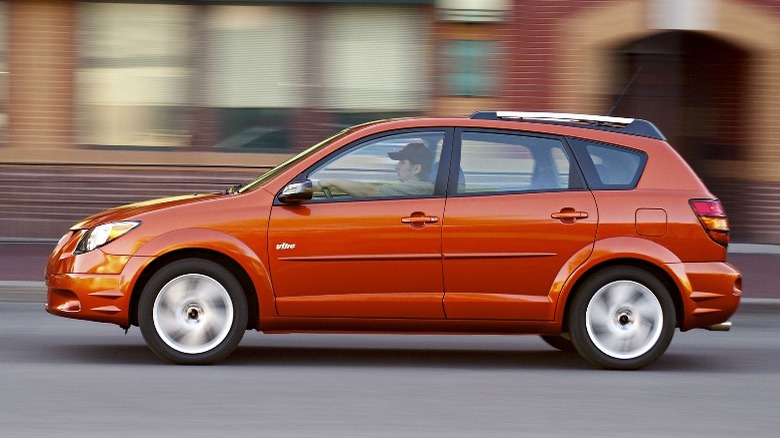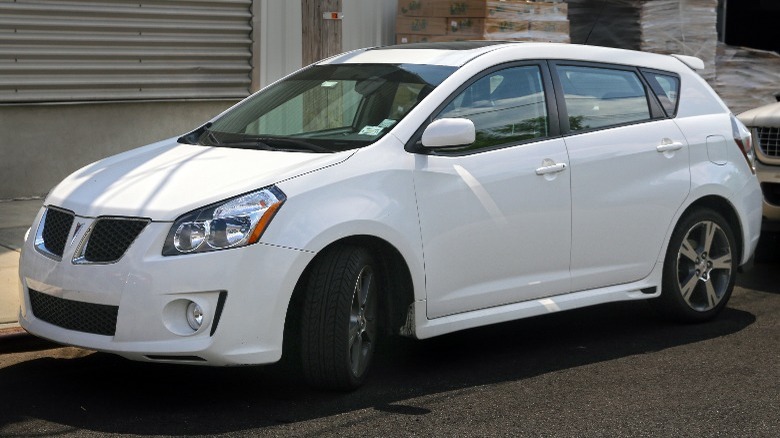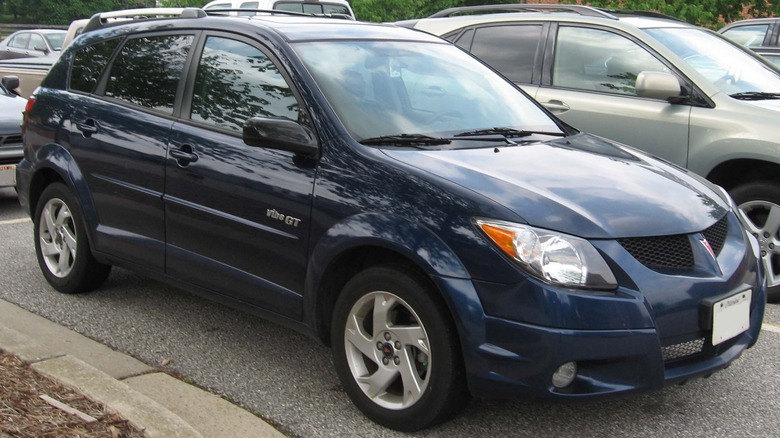The Best Years For Pontiac Vibe (And Some To Avoid)
The Pontiac Vibe was a bit of an oddity in the United States' automotive industry when it was introduced: a compact hatchback from an American automaker, designed in cooperation with a competitor, and manufactured in a domestically-located factory that was co-owned by that same competitor. The Vibe was introduced in 2002 and was produced through the 2010 model year when it was discontinued, along with all other Pontiac models. That same year, the brand was unceremoniously eliminated from the General Motors portfolio as part of restructuring moves mandated by the Federal Government after the automotive behemoth filed for Chapter 11 Bankruptcy protection in mid-2009.
Concurrently developed with its Toyota Matrix sibling, the Vibe offered some of the benefits of an SUV, like a flat load floor with its rear-seats folded, hat-friendly headroom, and available all-wheel drive. Driving enthusiasts could find elements to love about the Vibe, like the option of a manual transmission and Yamaha-massaged 2ZZ four cylinder in the GT trim level from 2003 to 2007 that it shared with the contemporary Toyota Celica GT-S.
Like many vehicles with Toyota internals, the Pontiac Vibe has earned a reputation for reliability. But like all vehicles produced for multiple years and generations, some years of the Vibe have a better track-record for dependability than others. Below are some of the best and worst years to consider from its relatively-brief time of production.
2005-2008 Pontiac Vibe: The first generation
The first generation of Pontiac Vibe consists of vehicles from the 2003-2008 model years, with 2005-2008 considered the most reliable models as reported by owners, according to CarComplaints. It was available in two trim levels, with the base model offered with a 1.8-liter four cylinder making 130 horsepower in front-wheel drive form, or 125 horsepower with all-wheel drive. Each had options for a five-speed manual or four-speed automatic. Those who opted for the GT were treated to a more powerful Yamaha-tuned 1.8-liter making 170 horsepower driving the front wheels and a six-speed manual transmission.
The base model was the better choice for owners prioritizing efficiency, with fuel economy as high as 30 miles per gallon on the highway. The enthusiast-oriented GT model managed only 27 highway miles per gallon, despite the additional sixth gear. Regardless of spec, the 2005 through 2008 Pontiac Vibe has proven to be a reliable vehicle model, with an average reliability rating of 4.9 out of 5 stars from consumers as reported to Kelley Blue Book. A quote from a long-time owner of a 2007 Vibe sums up their ownership experience on KBB, stating, "Going on 16 years without any major repairs. Only routine maintenance. Absolutely the best vehicle I have ever owned."
2010 Pontiac Vibe: Its last year of production
The second generation of the Pontiac Vibe brought an increase in size, as well as changes to its available powertrains and upgrades to the quality of its interior materials. The base model of the Vibe continued to offer a 1.8-liter 130 horsepower four cylinder as standard, with an available five-speed manual or four-speed automatic. The all-wheel drive version of the Vibe was only available with an automatic transmission. Choosing the GT trim brought a significantly larger 2.4-liter four cylinder, making 158 horsepower and five-speed automatic transmission as standard. The GT also had upgraded rear suspension to a more compliant and sophisticated multi-link independent setup.
As before, the base model 1.8-liter engine was the fuel-economy champ, making 28 miles per gallon (combined city and highway) — besting the larger 2.4-liter four cylinder by four miles per gallon. While fuel economy suffered somewhat in comparison to previous models, the 2010 model-year continued the Vibe's excellent reputation for reliability. Owners on Kelley Blue Book give this iteration of the Vibe a reliability rating of 4.9 out of 5 stars. On Cars.com, user RodM appreciates their experience with the 2010 model: "The Vibe is great transportation. It is very reliable and gets around in all weather. We have driven our vibe on many trips, and it just hums along."
[Image by Mr.choppers via Wikimedia Commons | Cropped and scaled | CC BY-SA 3.0]
These are the Pontiac Vibe years to avoid
Over its seven years of production, the Pontiac Vibe garnered an excellent overall reputation for reliability. Considering its Toyota roots as a mechanical twin to the Matrix, The Vibe's track record for dependability isn't that surprising. However, like any vehicle, there are certain years of the Vibe that are better to avoid when considering a purchase.
The 2003 Pontiac Vibe, the first year of the model line, is one of two production years that have a relatively poor reputation in comparison to the rest. Owners of this model year report transmission problems including outright failure as its Achilles' heel — so much so that it has earned the "Beware of Clunker" seal from CarComplaints.
Additionally, the 2009 Vibe — which was also the first production year of the second generation — is a model of the Pontiac that has suffered more mechanical issues than are common for the model. The most common reported problem is excessive oil consumption in the optional 2.4-liter engine — an issue that can be greatly exacerbated by an owner that does not properly maintain their vehicle with regular fluid changes.
[Image by IFCAR via Wikimedia Commons | Cropped and scaled | Public domain]



